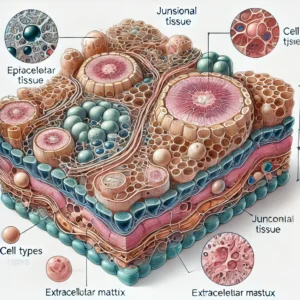Junctional Tissue
 Junctional tissue refers to the specialized area in the heart’s electrical conduction system located near the junction of the atria (upper chambers) and ventricles (lower chambers). It plays a crucial role in maintaining and regulating the heart’s rhythm, ensuring that electrical impulses are transmitted efficiently between these two parts of the heart.
Junctional tissue refers to the specialized area in the heart’s electrical conduction system located near the junction of the atria (upper chambers) and ventricles (lower chambers). It plays a crucial role in maintaining and regulating the heart’s rhythm, ensuring that electrical impulses are transmitted efficiently between these two parts of the heart.
Components of Junctional Tissue
The junctional tissue includes the following key structures:
- Atrioventricular (AV) Node
- A small cluster of cells situated in the interatrial septum (the wall between the atria), near the opening of the coronary sinus.
- The AV node slows down the electrical impulse from the sinoatrial (SA) node, allowing the ventricles enough time to fill with blood before they contract.
- Bundle of His (AV Bundle)
- A continuation of the AV node that carries the electrical signal from the AV node to the ventricles.
- It divides into the left and right bundle branches, ensuring the signal reaches both ventricles.
- Proximal Portions of the Bundle Branches
- These initial parts of the left and right bundle branches are sometimes considered part of the junctional area, as they facilitate the transition of signals from the atria to the ventricles.
Functions of Junctional Tissue
The junctional tissue is critical for:
- Relay of Electrical Signals:
It ensures that the impulse generated by the SA node is transmitted to the ventricles, causing coordinated contraction. - Delay of Impulse:
The AV node introduces a slight delay in the signal, allowing the atria to contract fully and push blood into the ventricles before they contract. - Backup Pacemaker Function:
- If the SA node (the heart’s primary pacemaker) fails, the junctional tissue can generate electrical impulses at a slower intrinsic rate (40-60 beats per minute).
- This provides a backup mechanism to maintain heart function.
Disorders Related to Junctional Tissue
Dysfunction in the junctional tissue can lead to rhythm abnormalities, including:
- Junctional Rhythm:
- Occurs when the AV node or nearby junctional tissue takes over as the pacemaker due to failure of the SA node.
- The heart rate is typically slower (40-60 beats per minute) and may cause symptoms like fatigue or dizziness.
- Heart Block:
- First-Degree Block: Slower conduction through the AV node, but all signals reach the ventricles.
- Second-Degree Block: Some signals fail to reach the ventricles.
- Third-Degree Block: Complete failure of conduction, requiring a pacemaker.
- Junctional Tachycardia:
- A rapid rhythm originating in the junctional tissue, often caused by stress, medications, or heart disease.
- It can lead to symptoms like palpitations, chest discomfort, or breathlessness.
- Re-entrant Tachycardias:
- Abnormal electrical loops involving the junctional tissue can cause rapid heart rhythms, such as atrioventricular nodal reentrant tachycardia (AVNRT).
Clinical Importance of Junctional Tissue
Understanding junctional tissue is vital in diagnosing and treating cardiac arrhythmias. Many therapeutic interventions, such as pacemaker implantation or ablation procedures, target this area to restore or modify electrical conduction.
In summary, the junctional tissue acts as both a bridge and a gatekeeper, ensuring proper timing and coordination in the heart’s contractions. Without its critical role, the heart’s efficiency and rhythmic consistency would be compromised.







